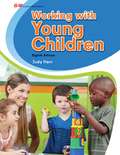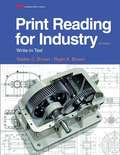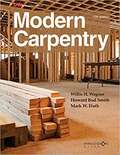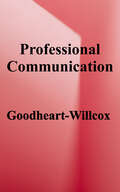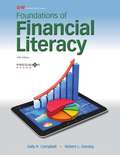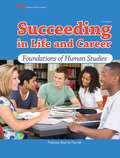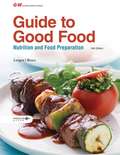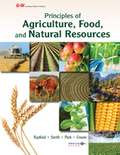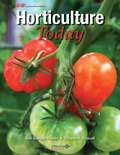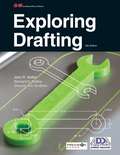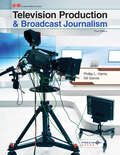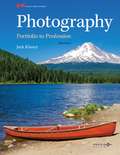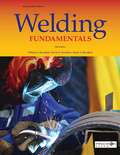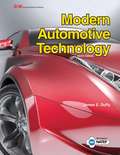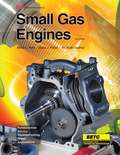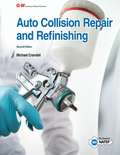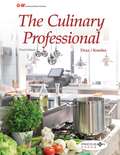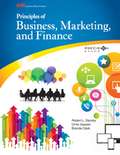- Table View
- List View
Working with Young Children
by Judy HerrWorking with Young Children introduces you to the field of early childhood education. The text begins by helping readers better understand young children and then progresses into developing guidance skills. Child development principles are applied to child care settings. You will also learn how to handle specific concerns related to infants, toddlers, school-age children, and children with special needs. All information needed to successfully earn the Child Development Associate (CDA) Credential™ is included. Readers prepare for the workplace by learning about licensing rules and regulations, different career paths, and safety considerations. Core values and principles from the NAEYC's Code of Ethical Conduct and Statement of Commitment are highlighted in their own appendix.
Print Reading for Industry
by Walter C. Brown Ryan K. BrownPrint Reading for Industry is ideal for beginning and intermediate students, in addition to those participating in on-the-job training. The text focuses on interpreting and visualizing drawings and prints used in industrial settings. This revised edition includes new content discussing therole of prints in the digital age and updates the coverage of geometric dimensioning and tolerancing to current standards. Additionally, it provides coverage of several foundational skills needed for print reading success, including basic mathematics, geometry principles, measurement tools, and thedesign process.
Modern Carpentry: Teaching Package Teacher's Resource Binder
by Howard Bud Smith Willis H. Wagner Mark W. HuthNIMAC-sourced textbook
Professional Communication
by Goodheart-Willcox PublisherThis book takes an integrated approach to teaching English/language arts skills that are vitally important in today's digital environment. The basic skills of writing, speaking, listening, and reading are interwoven into the content as each skill is presented and applied in context. <p><p>Students are guided through a step-by-step writing process to create clear and concise messages and develop professional skills that are that are sought after in the workplace. Topics such as making presentations, grammar basics, and digital citizenship prepare students for success in college and career and to become effective contributors in the 21st century. <p><p>Writing for specialized purposes, such as technical writing and social media, guides the development of writing expertise needed in today's job market. Portfolio development activities provide an opportunity for students to create a personal portfolio to use when applying for college, a community service position, or a job. <p><p>Exploring Communication Careers features examine a wide variety of opportunities in the Arts, A/V Technology and Communication career cluster. Career planning chapters help students to prepare, apply, and begin the first day on a job.
Succeeding in Life and Career, Foundations of Human Studies
by Frances Baynor ParnellSucceeding in Life and Career is an advanced comprehensive text designed to help teens adjust to change, especially as they become young adults. A lifespan development chapter provides understanding of how people change over time, from newborn to older adult. Career readiness is stressed, and each of the 16 career clusters is explored along with related jobs and their requirements for success. Skills development, financial literacy, healthy lifestyles, housing, and transportation topics are also included. Students gain hands-on experience building a portfolio by completing chapter projects, preparing them to create employment portfolios in the future. Critical thinking features found throughout the book develop student college and career readiness skills. Classroom learning and FCCLA participation are encouraged through chapter ending activities.
Succeeding in Life and career: Foundations of Human Studies
by Frances Baynor ParnellSucceeding in Life and Career is an advanced comprehensive text designed to help teens adjust to change, especially as they become young adults. A lifespan development chapter provides understanding of how people change over time, from newborn to older adult. Career readiness is stressed, and each of the 16 career clusters is explored along with related jobs and their requirements for success. Skills development, financial literacy, healthy lifestyles, housing, and transportation topics are also included. Students gain hands-on experience building a portfolio by completing chapter projects, preparing them to create employment portfolios in the future. Critical thinking features found throughout the book develop student college and career readiness skills. Classroom learning and FCCLA participation are encouraged through chapter ending activities.
Guide to Good Food: Nutrition and Food Preparation
by Deborah L. Bence Velda L. LargenGuide to Good Food: Nutrition and Food Preparation employs current nutrition information to inform students as they learn the roles nutrients play in their health throughout the life cycle. Comprehensive content on food selection, storage, preparation, and service gives students the tools needed to recognize and follow a nutritionally balanced diet, while animations bring content to life. Menus and recipes with easy-to-follow, step-by-step directions, and nutritional analyses are also included. Food-related careers are profiled in every chapter. * Enhanced visuals program employs infographics and images to emphasize content and improve recall. * The Foods of the World section explores the culture and cuisine of over 30 countries. * Students can complete and submit review questions digitally, enhancing instructor's assessment of students' comprehension and reducing paper waste.
Principles of Agriculture, Food, and Natural Resources: Applied Agriscience
by John S. Rayfield Kasee L. Smith Travis D. ParkNIMAC-sourced textbook
Horticulture Today
by Jodi Songer Riedel Elizabeth DriscollAn all-new option for introductory horticulture or plant science courses, Horticulture Today engages students with practical information they can use and hands-on activities they perform. Written by two dynamic agriculture educators, the text presents a contemporary overview of the horticulture industry, then provides thorough coverage of plant science, horticultural practices, landscape design and maintenance, and integrated pest management. In developing an appreciation for the diversity and global context of horticulture, Horticulture Today helps students to develop literacy in Green Industry careers as well as the skills they will need to succeed.
Exploring Drafting: Teaching Package Worksheets
by John R. Walker Bernard D. Mathis Shauna Ann ScribnerNIMAC-sourced textbook
Exploring Drafting
by John R. Walker Bernard D. Mathis Shauna Ann ScribnerExploring Drafting is designed for use in introductory courses as it stresses fundamental skills appropriate for beginning drafting students at any instructional level and teaches both manual and CAD drafting skills. Coverage includes basic geometric constructions, orthographic projection, and dimensioning practices. Techniques and procedures used in creating Multiview drawings, sectional views, pictorial views, and pattern developments are taught. The end-of-chapter drawing problems help student build problem-solving skills and practice drafting techniques. The text follows ASME practices and serves as an ADDA approved publication.
Television Production and Broadcast Journalism
by Phillip L. Harris Gil GarciaTelevision Production & Broadcast Journalism provides students with basic technical skills necessary to enter the television production industry as a production assistant, and introduces broadcast journalism theory. The text provides an overview of the equipment, job responsibilities, and techniques involved in both traditional studio production and remote location work. The activities and processes involved in each phase of production are presented and reinforced with realistic examples, numerous photos showing students in actual production situations, and engaging student activities. <p><p>Broadcast journalism coverage includes ethics and news judgment, types of stories, news writing, preparing news packages, and conducting interviews. The broadcast journalism topics address skills and qualities required in the industry, but also incorporate classroom-appropriate standards and practices.
Architecture: Residential Drafting and Design (Twelfth Edition)
by Clois E. Kicklighter W. Scott ThomasArchitecture: Residential Drafting and Design provides comprehensive instruction on traditional and computer-based methods of preparing architectural working drawings, as well as coverage of design and construction principles and methods. It is organized around the design-building process, a logical way for students to easily learn. It is intended to help build the necessary technical skills to communicate architectural ideas in an understandable, efficient, and accurate manner. Architecture: Residential Drafting and Design covers all phases of architectural drafting and design. In addition to providing information on architectural drafting, design, and construction, the text includes excellent coverage of computer-aided drafting and design (CADD), 3D parametric modeling applications, and building information modeling (BIM).
Architecture: Residential Drafting and Design (Twelfth Edition)
by Clois E. Kicklighter Joan C. Kicklighter W. Scott ThomasNIMAC-sourced textbook
Welding Fundamentals
by Kevin E. Bowditch Mark A. Bowditch William A. BowditchWelding Fundamentals is designed to provide students with a strong understanding of the underlying theory and skills required for successful welding, with a strong emphasis on safety. It provides all of the information needed to help students develop proficiency with the most common welding processes (including GTAW, GMAW, FCAW, SMAW, and oxyfuel welding), thermal cutting, basic print reading and weld symbology, and joint design and fit up. The text also introduces students to weld inspection and testing. Covers all of the key indicators for AWS SENSE Level-1 certification, so the book can be used in all courses leading to SENSE Level-1 certification. This book is designed so that sections of the book can be taught in any order, making the book easily adaptable to any course.
Modern Automotive Technology
by James E. DuffyModern Automotive Technology supports career readiness for those wishing to pursue a job in the automotive industry. Organized around the ASE automobile test areas, it details the construction, operation, diagnosis, service, and repair of late-model automobiles and light trucks. Student-focused content is presented using a building block approach that starts with the fundamental principles of system operation and progresses gradually to complex diagnostic and service procedures. Thorough coverage of the latest developments in the automotive field, including hybrid technology and direct gasoline injection, helps prepare students to service and repair today’s complex vehicles. Modern Automotive Technology is also a perfect reference for those preparing for the ASE automobile certification tests.
Small Gas Engines
by Alfred C. Roth W. Scott Gauthier Blake J. FisherThe Small Gas Engines textbook covers all areas of engine theory and service. The book includes extensive information on L-head, overhead valve, and overhead cam engine designs. The troubleshooting and engine service information in the book is generalized rather than manufacturer-specific so that it can be applied to a wide range of engine designs from different manufacturers. The book contains all of the service procedures needed to completely rebuild a small, single-cylinder gas engine. The theory sections of the book give the reader a sound understanding of the science involved in four-stroke and two-stroke internal combustion cycles in easy-to-understand language. They also provide the reader with clear explanations of the role of basic engine components, the benefits and operation of various engine designs, and up-to-date emission control information. Review questions at the end of each chapter reinforce the important information presented in that chapter. The suggested activities at the end of each chapter are hands on and research activities that help the students apply what they have learned in the text and expand their knowledge.
The Culinary Professional (Third Edition)
by Christopher Koetke John DrazThe Culinary Professional is the first step on the path to a career in the culinary field. It will provide you with the necessary skills for more advanced class work and expose you to the world of professional cooking. The foodservice industry, which employs most culinary professionals, is large and diverse. This text begins with an introduction to that industry's opportunities and challenges. You will learn what it takes to succeed in this growing field. Before you begin to cook, you should know how to be safe in the kitchen. Early chapters will explain how to protect your health and safety as well as that of your coworkers and customers. You will learn how to find a job and what is expected of you as an employee. A new chapter explores concepts and practices that promote sustainability in the kitchen. Chefs use many tools and select from an immense array of ingredients when preparing dishes. The Culinary Professional supplies a generous number of photos and clear descriptions of the tools and ingredients used in the professional kitchen. Step-by-step directions for basic culinary skills and cooking methods appear throughout the text. The presentation of your food is nearly as important as the preparation, and for this reason, a full chapter covers the principles of plating, design, and garnishing. A new chapter explains how to analyze cuisines and explores various international cuisines. Successful chefs must be able to do more than simply prepare delicious dishes. You will learn about the importance of working with other departments and managing resources. Welcome to the first step on your path to a career in culinary!
Principles of Business, Marketing, and Finance
by Brenda Clark Robert L. Dansby Chris GassenNIMAC-sourced textbook
Principles of Business, Marketing, and Finance
by Brenda Clark Robert L. Dansby Chris GassenPrinciples of Business, Marketing, and Finance is a contemporary text that presents the business concepts that are vitally important in today’s workplace. The basics of business, marketing, and finance are introduced in an easy-to-understand manner that helps students connect the concepts to their everyday life. By studying this text, students will learn the basic principles of commerce, which can help them become valuable employees and responsible citizens. Personal finance information is also presented to help students become knowledgeable consumers and financially literate individuals.
